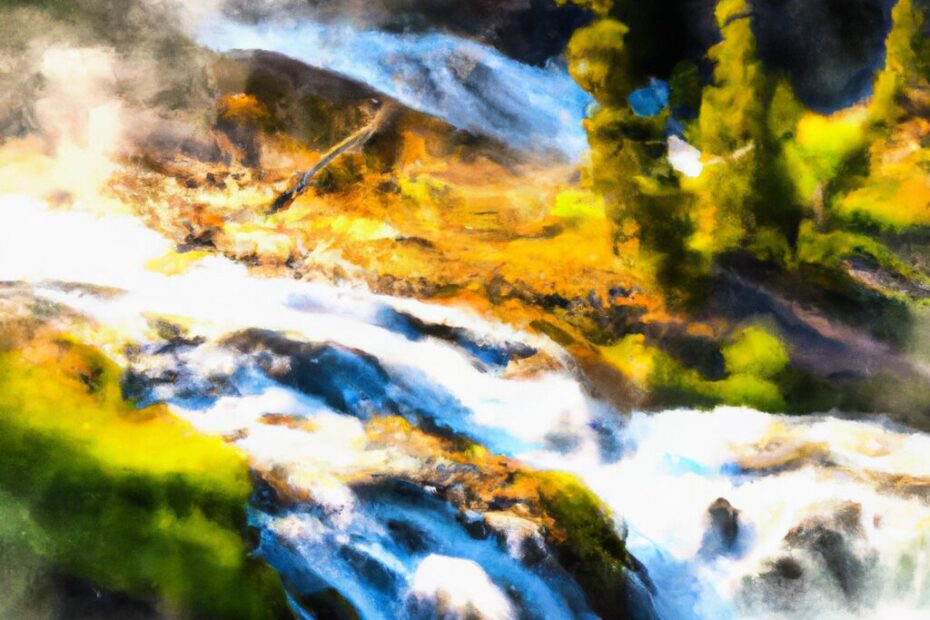Geysers, the natural wonders that shoot hot water and steam into the air, are truly a sight to behold. But have you ever wondered how these incredible phenomena form? Or where they can be found around the world?
In this article, we will explore the characteristics of geysers, including their eruptive cycle and hot spring connection. We will also delve into what causes geysers to erupt and the different types of geysers that exist. Plus, we’ll take a look at some of the most famous geysers, from Old Faithful in the USA to Strokkur in Iceland.
So sit back, relax, and prepare to be amazed by the fascinating world of geysers.
What Are Geysers?
Geysers are mesmerizing thermal features that captivate visitors with their spectacular eruptions, commonly found in renowned locations like Yellowstone National Park.
These extraordinary geothermal wonders are a testament to the underlying hydrothermal activity pulsating beneath the Earth’s surface. The unique combination of superheated water, trapped steam, and pressure buildup creates the perfect conditions for geysers to put on their captivating displays. Yellowstone National Park, in particular, boasts a remarkable concentration of geysers, with iconic ones like Old Faithful regularly drawing crowds eager to witness nature’s raw power in action.
The continuous cycle of heating and cooling deep within the park’s volcanic system fuels these awe-inspiring geological phenomena, making Yellowstone a prime destination for anyone fascinated by the forces shaping our planet.
How Do Geysers Form?
The formation of geysers is a fascinating process driven by a combination of underground water, intense heat, and pressure that culminates in spectacular eruptions of steam and water.
- When underground water seeps into the Earth’s crust, it gets heated by magma deep below the surface. This heated water rises back towards the surface due to the lower density of hot water compared to cold water.
- As the water rises, the pressure from the overlying rocks builds up, creating a sort of ‘pressure cooker’ effect. Eventually, this pressure becomes so intense that it forces the superheated water to erupt through vents in the Earth’s surface, resulting in the majestic displays that we witness in geyser eruptions.
Where Can Geysers Be Found?
Geysers can be found in volcanic regions worldwide, with notable concentrations in iconic locations such as Yellowstone National Park, a renowned geothermal hotspot.
These natural wonders are not limited to just Yellowstone, as other volcanic regions around the globe boast their fair share of geothermal activity.
For instance, the geysers of Iceland, like the famous Strokkur in the Haukadalur valley, attract visitors with their impressive eruptions.
New Zealand’s Rotorua region is known for its diverse collection of geysers, mud pools, and hot springs, creating a unique landscape shaped by volcanic forces.
These destinations showcase the mesmerizing power of nature and offer visitors a glimpse into the Earth’s fiery depths.
What Are the Characteristics of Geysers?
The characteristics of geysers encompass their explosive eruptions, bubbling boiling water, mineral-rich content, and the utilization of underground water sources.
These hydrothermal wonders showcase spectacular eruption behavior, often reaching impressive heights as superheated water forcefully shoots through vents in the Earth’s surface. The boiling water displays create a mesmerizing sight, with steam billowing into the air against the backdrop of surrounding landscapes. Over time, mineral deposits left behind by evaporating water form colorful terraces, enhancing the otherworldly appeal of geyser basins. Underground water plays a vital role in fueling these thermal features, as it seeps into the Earth where it is heated by magma, creating the ideal conditions for geyser activity.
Eruptive Cycle
The eruptive cycle of geysers follows a rhythmic pattern characterized by varying eruption frequencies and distinct behaviors that contribute to their mesmerizing displays.
These natural phenomena exhibit different behaviors during their various phases of activity. In the dormant phase, geysers may show minimal to no activity, with only occasional steam emissions. As they transition into the pre-eruptive phase, signs such as increased water temperature and bubbling become more apparent. The climax of their eruptive cycle is marked by powerful eruptions, shooting water and steam high into the air. Following this, geysers enter a period of quietude, preparing for the cycle to repeat itself in a fascinating display of nature’s rhythm.
Hot Spring Connection
Geysers are intricately connected to hot springs, sharing similarities in their water sources, reliance on geothermal reservoirs, and the presence of thermal springs in their vicinity.
These natural hydrothermal features are both formed by underground water being heated by magma or other geological processes within the Earth’s crust. The water in geysers and hot springs often originates from rainfall or snowmelt that seeps deep into the ground, where it is heated and pressurized before returning to the surface. Geothermal reservoirs, which hold the heated water, are crucial components that supply the thermal energy to create the steam and hot water that characterize both geysers and hot springs.
Conduit System
Geysers rely on a complex conduit system that includes fissures, basins, and a geothermal gradient to channel superheated water and steam towards the surface.
The fissures within the earth’s crust play a crucial role in this system, acting as pathways for the hot water and steam generated deep below the surface. These narrow cracks allow the pressurized water to travel upwards, gaining energy and pressure as it moves through the fractured rock. Basins, on the other hand, provide reservoirs where the water collects and builds up before being expelled in a powerful eruption. The geothermal gradient, the increase in temperature with depth, ensures that the water becomes superheated, creating the conditions for the explosive release of energy that characterizes a geyser eruption.
Silica Deposition
Silica deposition plays a crucial role in geyser formation, with mineral-rich water leaving behind stunning silica deposits that solidify into intricate structures like silica sinter and sedimentary rocks.
These deposits are not only visually appealing but also serve as a record of the dynamic interactions between water and minerals over time. The formation of silica sinter, in particular, showcases the gradual build-up of silica layers as water carries dissolved minerals to the surface. This process highlights the intricate balance of forces at play in geothermal environments, where the unique conditions allow for the gradual transformation of soluble silica into solid mineral structures, contributing to the fascinating geological landscapes found in geyser regions.
Geyserite Formation
Geyserite formation is a dynamic process influenced by factors like vapor pressure and eruption height, resulting in the creation of unique geological formations around geyser vents.
Vapor pressure plays a significant role in the deposition of geyserite as it affects the boiling point of the water. Higher vapor pressure can lead to more explosive eruptions, propelling the mineral-rich water higher into the air. As the water droplets cool and evaporate during the eruption, geyserite minerals are left behind, gradually building up around the vent. The height of the eruption also determines the pattern and extent of geyserite deposition, shaping the stunning terraces and cones that mark the landscape near active geysers.
What Causes Geysers to Erupt?
Geysers erupt due to a combination of intense heat from volcanic activity, water reaching boiling point under pressure, and the subsequent release of steam and water in a spectacular display.
The eruption mechanism of geysers is a fascinating interplay of natural forces. Deep underground, volcanic heat warms pockets of water trapped below the Earth’s surface. As this water approaches boiling point, pressure builds up, contained within the cracks and fissures of the geyser’s plumbing system. Eventually, the pressure becomes so intense that it overcomes the weight of the water column above. In a burst of energy, the superheated water flashes into steam, propelling a column of water and mist high into the air. This cycle of heating, pressurization, and eruption showcases the dynamic nature of geothermal processes.
Heat Source
The heat source fueling geyser eruptions originates from geothermal reservoirs beneath the Earth’s surface, where intense energy powers the boiling of water and steam production.
These geothermal reservoirs act as natural sources of heat, created by the Earth’s internal energy processes and volcanic activity. As the heat rises from these reservoirs, it converts the water stored in underground aquifers into steam, creating pressure that eventually propels the water upwards through vents and fissures in the Earth’s crust. This energy conversion process is crucial in sustaining the regularity and power of geyser eruptions, showcasing the vital role that geothermal energy plays in driving these natural phenomena.
Water Supply
The water supply for geysers is sourced from underground reserves within the Earth’s crust, where natural processes heat and pressurize the water before it surfaces in geyser eruptions.
As this underground water seeps deeper into the Earth’s crust, it encounters intense heat from the Earth’s mantle. This heat causes the water to rise in temperature, forming a high-pressure environment below the surface. The combination of heat and pressure builds up until the water eventually finds a pathway to escape, resulting in the spectacular eruptions that characterize geysers. This process is a vivid demonstration of the dynamic interactions between water and the Earth’s internal forces, showcasing the incredible power of nature’s water cycle.
Constriction in Conduit
A constriction in the geyser’s conduit system can lead to increased pressure buildup, influencing the eruption frequency and the intensity of steam and water releases during geyser events.
This pressure build-up occurs when the narrowed pathway restricts the flow of steam and water, creating a bottleneck effect. As a result, the geyser’s internal pressure continues to mount until it reaches a critical point, triggering a powerful eruption. Vent restrictions play a crucial role in this process, as they determine the rate at which steam and water can escape. When these vents are constrained, the geyser expels its contents with greater force, producing more explosive eruptions that can be visually spectacular but also potentially dangerous.
What Are the Different Types of Geysers?
Various types of geysers exist, including cone geysers that showcase eruptions from a central vent in geyser basins fed by superheated water from complex geothermal systems.
- Cone geysers, known for their distinctive cone-shaped formation, are captivating natural wonders that draw inquisitive visitors to witness their powerful eruptions. These geysers stand as testaments to the intricate interplay between underground heat sources and surface manifestations.
- The centralized vent eruptions of cone geysers create spectacular displays, sending scalding hot water and steam high into the air with impressive force. Within geyser basins, these cone geysers often serve as focal points, attracting researchers and nature enthusiasts alike eager to unravel the mysteries of these dynamic hydrothermal features.
Cone Geysers
Cone geysers feature distinctive cone-shaped structures and eruptions that can reach impressive heights, reflecting the underlying geothermal gradient and intense energy dynamics at play.
These geysers have a unique cone formation that is a result of mineral deposits built up over time from the erupting hot water and steam. The eruptions from these cones can soar to stunning heights, creating awe-inspiring displays that showcase the raw power of the Earth’s geothermal energy. The geothermal gradient, which is the rate of temperature increase with depth in the Earth’s crust, plays a significant role in determining the intensity and frequency of eruptions from these cone geysers.
Fountain Geysers
Fountain geysers exhibit dramatic gushes of water and steam propelled into the air, often located in geothermal fields where underground water interacts with geothermal activity to create these dynamic displays.
These geysers are renowned for their powerful eruptions that can shoot water and steam to incredible heights, captivating onlookers with their force and beauty. The combination of underground water sources and geothermal heat generates the pressure needed for these impressive displays. The water in fountain geysers tends to be crystal clear, reflecting the purity of the underground sources from which it originates. These geysers are not only mesmerizing but also play a critical role in understanding the complex interactions between water and heat deep beneath the Earth’s surface.
Fountain Cone Geysers
Fountain cone geysers combine the features of fountains and cone structures, often adorned with silica sinter formations, showcasing a distinct eruption cycle that mesmerizes onlookers.
These geysers, nestled in various geothermal regions around the world, are known for their hybrid characteristics that set them apart from other geothermal features. The silica sinter decorations that encrust the cones create a beautiful contrast to the erupting water, adding a touch of whimsy to the landscape. The cyclical nature of their eruptions, punctuated by periods of dormancy and intense activity, adds an element of unpredictability and excitement, drawing in geology enthusiasts and tourists alike to witness these natural wonders in action.
Erupting Spring Geysers
Erupting spring geysers manifest as hot water reservoirs surging to the surface due to underlying tectonic activity, creating dynamic displays of geothermal power in action.
These natural phenomena often exhibit distinct behaviors, such as periodicity in their eruptions and varying intensities based on the pressure build-up within their underground chambers. The geological processes, like the movement of Earth’s crustal plates, play a crucial role in shaping their behavior. As the subsurface water heats up and expands, it seeks pathways to escape, resulting in the spectacular eruptions that we associate with these majestic geysers.
What Are the Famous Geysers Around the World?
Some of the world’s most famous geysers include the iconic Old Faithful Geyser in the USA, the mesmerizing Strokkur Geyser in Iceland, and the impressive Pohutu Geyser in New Zealand.
These geysers attract millions of visitors each year, drawn to their spectacular displays of boiling water shooting high into the air. Old Faithful, known for its predictable eruptions, showcases the raw power of geothermal activity, captivating audiences with its regularity. Strokkur, on the other hand, surprises onlookers with its frequent eruptions occurring every few minutes, creating a dynamic and unpredictable experience. Pohutu, with its massive plumes of steam and water, stands as a testament to the unique geological features found in the geothermal wonderland of New Zealand.
Old Faithful Geyser (USA)
Old Faithful Geyser in the USA is renowned for its predictable eruptions with impressive heights, fueled by a deep geothermal reservoir that sustains its iconic geothermal displays.
Visitors from around the world are captivated by the regularity of Old Faithful’s eruptions, which occur approximately every 60 to 110 minutes, making it one of the most reliable geysers on Earth.
The geyser’s eruptions can reach heights ranging from 100 to 184 feet, creating a mesmerizing spectacle for onlookers. This consistent performance is made possible by the vast geothermal reservoir beneath the surface of Yellowstone National Park, where Old Faithful stands as a symbol of the powerful forces at work beneath the Earth’s crust.
Strokkur Geyser (Iceland)
Strokkur Geyser in Iceland is famed for its bubbling prelude to eruptions and its dynamic eruption behavior, offering visitors an enchanting display of geothermal power in action.
As the pressure builds beneath the earth’s surface, the water within Strokkur Geyser starts to bubble and churn, creating an anticipation for the imminent eruption. The bubbling patterns create a mesmerizing dance of energy, captivating those lucky enough to witness it.
When Strokkur Geyser finally erupts, shooting scalding water high into the air, the sheer power and force on display are truly awe-inspiring. Visitors can feel the vibrations and hear the rumbling as the geyser erupts, engaging all their senses in the immersive geothermal experience.
Pohutu Geyser (New Zealand)
Pohutu Geyser in New Zealand captivates audiences with its powerful gushes of water and steam, showcasing the diverse geothermal features that make it a standout attraction in the region.
Visitors are enthralled by the sheer force and height of the water discharges, reaching impressive heights against the backdrop of the steamy mist. Surrounding the geyser, a mesmerizing assortment of bubbling mud pools, colorful mineral terraces, and hissing steam vents create a surreal geothermal gallery that highlights the earth’s dynamic forces. The unique geothermal landscape around Pohutu Geyser sets it apart as a natural wonder, drawing travelers from far and wide to witness this remarkable display of nature’s power.
Last Updated on February 7, 2024 by Jon Waraas – Originally Posted: February 6, 2024

I’m Jon Waraas, and I’ve been navigating the online world since 2006. By day, I’m the proud owner of some eCommerce gems, and by night, I’m the voice behind the adventures on Waraas.Com.
My heart, however, belongs to the wild beauty of Yellowstone National Park. I’ve got a collection of websites dedicated to sharing the wonders of this natural masterpiece. Oh, and did I mention? I’m currently building my own cabin inside the ghost town of Gilmore, Idaho – a cabin with tales to tell!
When I’m not immersed in the digital realm, you’ll find me lacing up my boots for a good hike or setting up camp under the star-studded sky.




